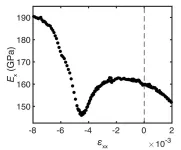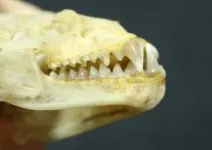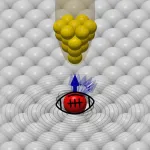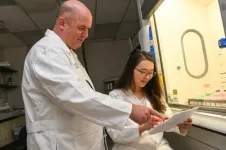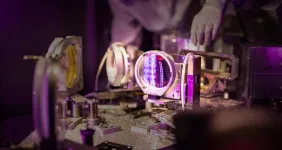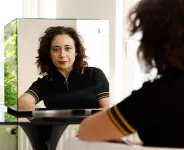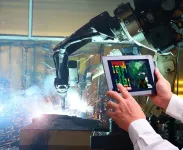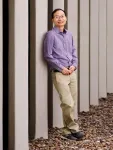(Press-News.org) The hardness of materials is determined by the strength of the chemical bonds that are formed between the electrons of the neighbouring atoms. For example, the bonds in diamond are very strong, so it is one of the hardest materials known. The bonding is rooted in the laws of quantum mechanics, and the complex compounds that are of most interest in forefront research today are known as ‘quantum materials.’ In many quantum materials, layers of strongly bonded atoms separate layers in which current can flow due to a small subset of the electrons in the material. An intuitive picture is that the strongly bonded layers determine the hardness, giving the current-carrying electrons a rigid atomic background, called a lattice, in which to flow.
The flowing electrons and the lattice know about each other, and if the lattice changes for some reason there will be effects on the current patterns. If the flowing electrons interact strongly with each other, they can spontaneously change current patterns, but if that happens, the effect on the lattice is usually very weak. Indeed, because the lattice bonding is usually so strong, the lattice is often thought of as dominating the current-carrying electrons, and even a very weak change of the lattice is often proposed to be the driver of the current pattern change.
In newly published work [1], a team from our Institute has uncovered clear proof of a case in which a tiny fraction of the current-carrying electrons can dominate all the others and make the lattice much softer. After the experiment was performed in-house, we collaborated with colleagues from Germany, Japan, Korea and the United States to understand the surprising result. An explicit model constructed by the groups of Joerg Schmalian and Markus Garst at the Karlsruhe Institute of Technology was crucial to unravelling the detective story, as were results from complementary experiments published in 2022 [2]. The work gives a new perspective on a decades-old problem, and will, we hope, be influential for future research.
[1] H. M. L. Noad, K. Ishida, Y.-S. Li, E. Gati, V. Stangier, N. Kikugawa, D. A. Sokolov, M. Nicklas, B. Kim, I. I. Mazin, M. Garst, J. Schmalian, A. P. Mackenzie & C. W. Hicks, Giant lattice softening at a Lifshitz transition in Sr2RuO4, Science [volume TBD], [pages TBD] (2023). DOI: https://doi.org/10.1126/science.adf3348
[2] Y.-S. Li, M. Garst, J. Schmalian, S. Ghosh, N. Kikugawa, D.A. Sokolov, C. W. Hicks, F. Jerzembeck, M. S. Ikeda, Z. Hu, B. Ramshaw, A. W. Rost, M. Nicklas & A. P. Mackenzie, Elastocaloric determination of the phase diagram of Sr2RuO4, Nature 607, 276-280 (2022). DOI: https://doi.org/ 10.1038/s41586-022-04820-z
END
Conduction electrons drive giant, nonlinear elastic response in Sr2RuO4
2023-10-26
ELSE PRESS RELEASES FROM THIS DATE:
New quantum effect demonstrated for the first time: Spinaron, a rugby in a ball pit
2023-10-26
Extreme conditions prevail in the Würzburg laboratory of experimental physicists Professor Matthias Bode and Dr. Artem Odobesko. Affiliated with the Cluster of Excellence ct.qmat, a collaboration between JMU Würzburg and TU Dresden, these visionaries are setting new milestones in quantum research. Their latest endeavor is unveiling the spinaron effect. They strategically placed individual cobalt atoms onto a copper surface, brought the temperature down to 1.4 Kelvin (–271.75° Celsius), and then subjected them to a powerful external magnetic field. “The magnet we use costs half a million euros. It’s not something that’s widely available,” explains ...
Researchers identify amino acid that may play a key role for predicting and treating long COVID
2023-10-26
University of Alberta researchers have identified an amino acid that may play a key role in predicting poor clinical outcomes and the treatment of long COVID.
In research published today in Cell Reports Medicine, the team says it has developed a predictive test to determine which patients with COVID-19 will go on to develop longer-term symptoms and proposes a clinical trial of an already-approved supplement as a potential treatment.
“This research helps us understand what’s happening in the bodies of people ...
UTHealth Houston researchers awarded $3.4M NIH grant to study pharmaceutical therapies to treat acute respiratory distress syndrome
2023-10-26
A four-year, $3.4 million grant to investigate molecular mechanisms and therapeutic treatments for acute respiratory distress syndrome (ARDS) has been awarded to UTHealth Houston researchers by the National Heart, Lung, and Blood Institute, part of the National Institutes of Health.
The study led by principal investigators Holger Eltzschig, MD, PhD, professor and chair of the Department of Anesthesiology, Critical Care and Pain Medicine at McGovern Medical School at UTHealth Houston, and Xiaoyi Yuan, PhD, assistant professor in the department, is built on many years of research in the endogenous ...
Renewed support for high power laser facilities will benefit discovery science and inertial fusion energy research at SLAC
2023-10-26
Research and technology development for plasma physics and fusion energy at the Department of Energy’s SLAC National Accelerator Laboratory just got a boost from a LaserNetUS award.
In total, the DOE’s Office of Science awarded $28.5 million to advance discovery science and inertial fusion energy, including a three-year grant for the development and operations of the Matter in Extreme Conditions (MEC) instrument at SLAC’s Linac Coherent Light Source (LCLS).
MEC has been home to high intensity laser experiments since 2012, and joined ...
TUM professor develops energy-saving AI chip
2023-10-26
The basic idea is simple: unlike previous chips, where only calculations were carried out on transistors, they are now the location of data storage as well. That saves time and energy. “As a result, the performance of the chips is also boosted,” says Hussam Amrouch, a professor of AI processor design at the Technical University of Munich (TUM). The transistors on which he performs calculations and stores data measure just 28 nanometers, with millions of them placed on each of the new AI chips. The chips of the future will have to be faster and more efficient than earlier ones. Consequently, ...
SETI Institute artist-in-residence Daniela De Paulis to receive 2023 Europlanet Prize for Public Engagement
2023-10-26
SETI Institute Artist-in-Residence Daniela De Paulis to Receive 2023 Europlanet Prize for Public Engagement
Daniela de Paulis is honored for her work bringing space and planetary science to international audiences.
October 26, 2023, Mountain View, CA -- The SETI Institute is thrilled to announce that Daniela De Paulis, a SETI Artist-in-Residence (SETI AIR), will be honored with the prestigious 2023 Europlanet Prize for Public Engagement. De Paulis’ groundbreaking project, ‘A Sign in Space,’ invited a global audience to participate in decoding a simulated message from an extraterrestrial ...
Genomic screening to identify iron overload encourages patients to seek treatment and condition management, study finds
2023-10-26
DANVILLE, Pa. – Genomic screening to identify hemochromatosis—a disorder that causes iron levels in the body to rise to dangerous levels—encourages people with the condition to seek treatment and ongoing management, a Geisinger study found.
Hereditary hemochromatosis type 1 (HH1), caused by a change in the HFE gene, is underdiagnosed, often resulting in missed opportunities for early and consistent treatment. Without treatment, hemochromatosis can cause iron overload, a buildup of iron that can damage many parts of the body. Treatment of hemochromatosis includes regular monitoring of iron levels and removing excess iron ...
People with autism less likely to succumb to bystander effect, York University father-son research duo finds
2023-10-26
People with autism less likely to succumb to bystander effect, York U father-son research duo finds
Schulich School of Business and Faculty of Health researchers say that while as many as 90 per cent of people with autism are unemployed or underemployed, their study points to the benefits of having neurodivergent people in the workplace
TORONTO, Oct. 26, 2023 — A well-established psychological theory states that most of us are less likely to intervene in a bad situation if other people are present, and this ‘bystander effect’ also applies to workplace settings. However, new research led ...
UTSA receives $500,000 US Economic Development Administration grant to build secure manufacturing hub in South Texas
2023-10-26
(San Antonio, October 26, 2023) -- The Cybersecurity Manufacturing Innovation Institute (CyManII) at The University of Texas at San Antonio (UTSA) has been selected by the U.S. Economic Development Administration (EDA) to establish an ecosystem that will promote secure manufacturing strategies across South Texas. The Secure Manufacturing in South Texas Strategy Development Consortium, funded by a $500,000 Tech Hubs Strategy Development Grant, will enable CyManII to take initial steps to develop a Secure Manufacturing Tech Hub that will mature technologies, enhance business competitiveness ...
Asian American Engineer of the Year goes to Sandia Labs computer scientist
2023-10-26
ALBUQUERQUE, N.M. — Tian Ma, a distinguished computer engineer in research and development at Sandia National Laboratories, has been honored as a 2023 Asian American Engineer of the Year by the Chinese Institute of Engineers-USA. Each year, CIE recognizes exceptional Asian American engineers who demonstrate strong technical skills, leadership abilities and a commitment to public service. Previous recipients of this award include Nobel laureates and astronauts.
Ma’s expertise in data analysis and processing has propelled him to national recognition as an expert in detection algorithms and tracking systems. His journey ...
